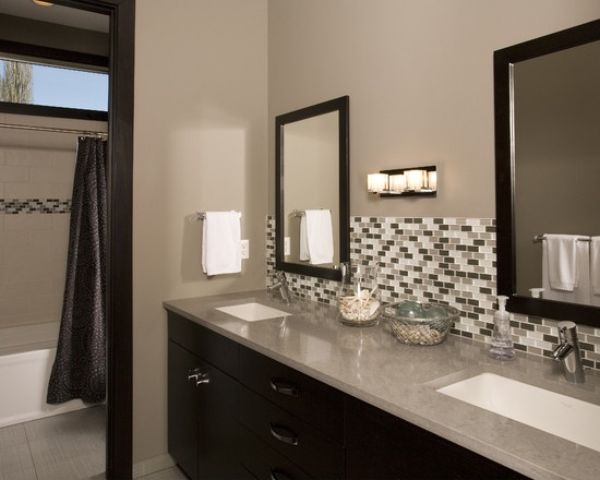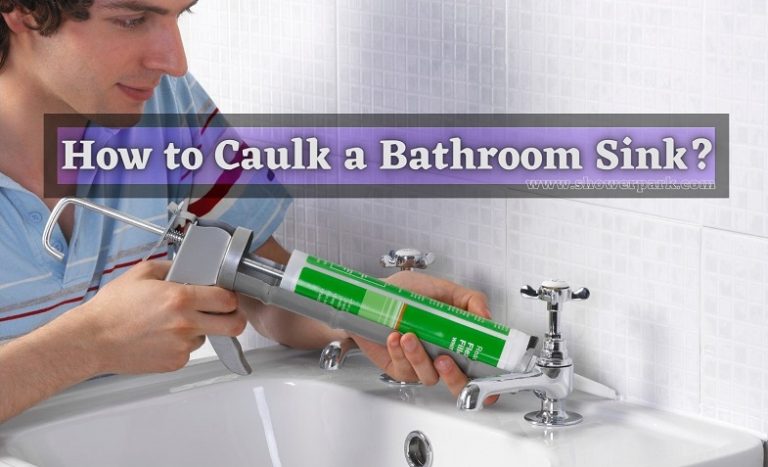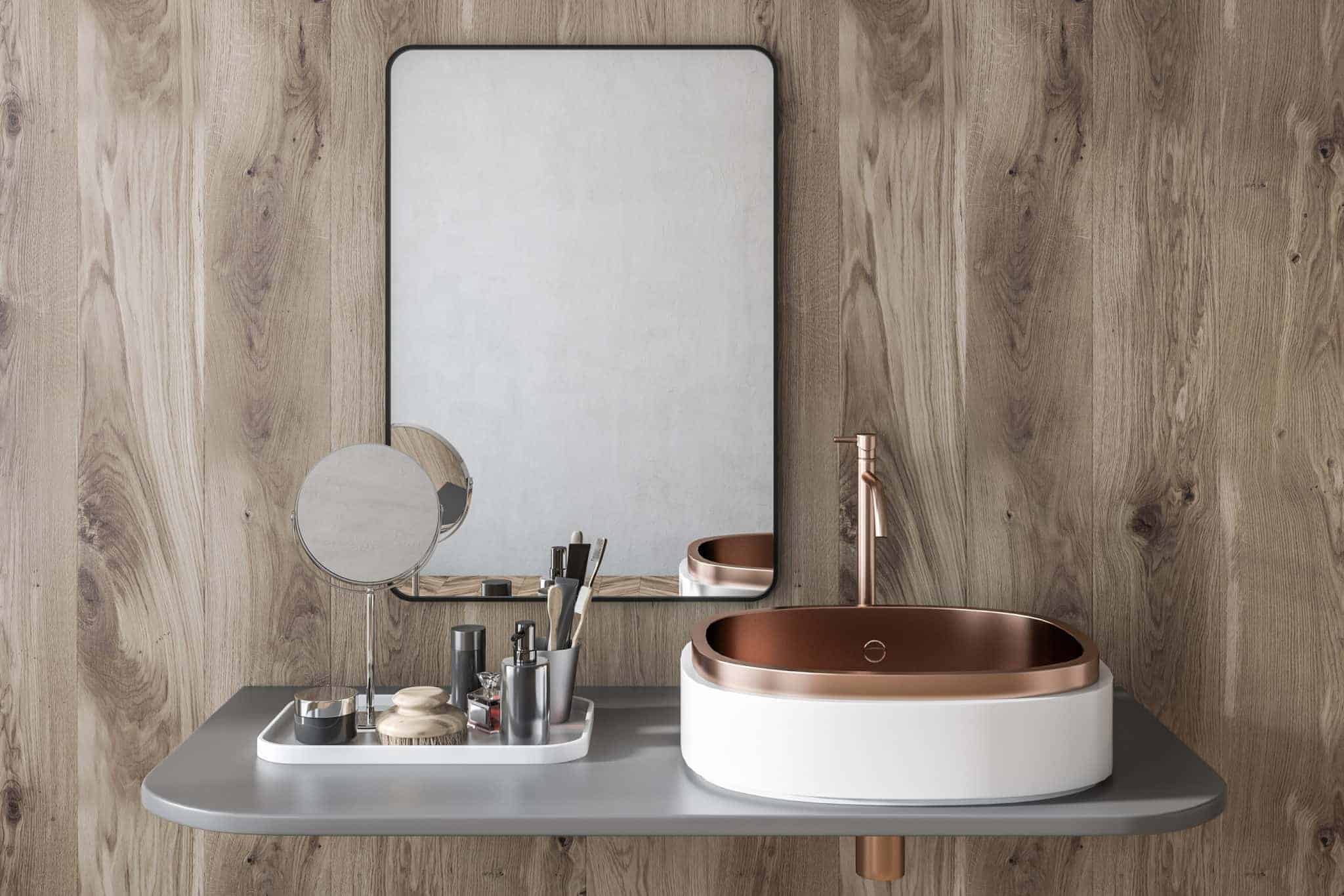If you're wondering whether or not you should caulk the tile backsplash for your bathroom sink, the answer is a resounding yes. Caulking is an important step in the installation process of a tile backsplash, and it offers many benefits that make it worth the time and effort. Not only does caulk provide a clean and finished look, it also helps to protect the grout and tile from water damage and stains. It also prevents any gaps or cracks from forming between the backsplash and the sink, which can lead to moisture buildup and potential mold growth. So, if you want to ensure the longevity and durability of your bathroom sink backsplash, caulking is a crucial step that should not be skipped.Should I Caulk Tile Backsplash for Bathroom Sink?
Caulking a bathroom sink backsplash may seem like a daunting task, but with the right tools and techniques, it can be a fairly simple and straightforward process. Here's a step-by-step guide to help you achieve a professional-looking caulk job: Step 1: Choose the Right Caulk Before you get started, it's important to choose the right caulk for your bathroom sink backsplash. Silicone caulk is the most commonly used type for this purpose, as it is water-resistant and flexible. Make sure to choose a caulk that is specifically labeled for use in bathrooms. Step 2: Prepare the Surface Before applying caulk, you'll need to prepare the surface by cleaning it thoroughly and removing any old caulk or debris. Use a mild cleaner and a scrub brush to ensure the surface is free of any dirt or grime. Step 3: Cut the Tip of the Caulk Tube Using a utility knife, cut the tip of the caulk tube at a 45-degree angle. This will allow for a smooth and even application of the caulk. Step 4: Apply the Caulk Squeeze the caulk into the gap between the sink and the backsplash, moving the tube along the seam in a steady and even motion. Make sure the caulk fills the gap completely and evenly. Step 5: Smooth Out the Caulk Use a caulk tool or your finger to smooth out the caulk and remove any excess. Wipe your finger or the tool with a damp cloth between each pass to ensure a clean and smooth finish. Step 6: Let it Dry Allow the caulk to dry for at least 24 hours before using the sink or getting it wet. This will ensure that the caulk sets properly and provides a strong seal.How to Caulk a Bathroom Sink Backsplash
As mentioned earlier, silicone caulk is the most commonly used type for bathroom sink backsplashes. It is flexible, water-resistant, and offers a strong seal. Some of the best silicone caulks for this purpose include GE Silicone II, DAP Kwik Seal Plus, and Red Devil Create-A-Color. Other options include acrylic latex caulk, which is easier to clean up and comes in a variety of colors to match your backsplash, and polyurethane caulk, which is extremely durable and can withstand harsher conditions. Ultimately, the best caulk for your bathroom sink backsplash will depend on your personal preference and the specific needs of your space.Best Caulk for Bathroom Sink Backsplash
If you're installing a tile backsplash in your bathroom, it's important to caulk the seams properly to ensure a clean and finished look. Here's a step-by-step guide to help you caulk a tile backsplash: Step 1: Clean the Surface Before applying caulk, make sure the surface is clean and free of any dust, debris, or grime. Use a mild cleaner and a scrub brush to thoroughly clean the area. Step 2: Prepare the Caulk Cut the tip of the caulk tube at a 45-degree angle, and then puncture the seal inside the tip using a thin wire or nail. This will allow the caulk to flow smoothly and evenly. Step 3: Apply the Caulk Squeeze the caulk into the gap between the tiles, moving the tube along the seam in a steady and even motion. Make sure the caulk fills the gap completely and evenly. Step 4: Smooth Out the Caulk Use a caulk tool or your finger to smooth out the caulk and remove any excess. Wipe your finger or the tool with a damp cloth between each pass to ensure a clean and smooth finish. Step 5: Let it Dry Allow the caulk to dry for at least 24 hours before using the area or getting it wet. This will ensure that the caulk sets properly and provides a strong seal.Step-by-Step Guide to Caulking a Tile Backsplash
Caulking a bathroom sink backsplash offers several important benefits that make it a crucial step in the installation process. These include: Waterproofing: Caulk helps to seal any gaps or cracks between the sink and the backsplash, preventing water from seeping in and causing damage or mold growth. Protection: Caulk also helps to protect the grout and tile from water damage and stains, extending their lifespan and keeping your bathroom looking new. Clean and Finished Look: A properly caulked backsplash provides a clean and finished look, eliminating any unsightly gaps or cracks and giving your bathroom a professional appearance.Importance of Caulking a Bathroom Sink Backsplash
When it comes to choosing the right caulk for your tile backsplash, there are a few factors to consider: Type of Caulk: As mentioned earlier, silicone caulk is the most commonly used type for tile backsplashes. However, acrylic latex and polyurethane caulks are also suitable options depending on your specific needs. Color: If you want the caulk to blend in seamlessly with your backsplash, choose a color that matches or is close to the color of your grout. Water Resistance: If your backsplash is in an area that is frequently exposed to water, make sure to choose a caulk that is labeled as "waterproof" or "water-resistant." Brand and Quality: It's always a good idea to choose a reputable brand and a high-quality caulk to ensure a strong and long-lasting seal.How to Choose the Right Caulk for Your Tile Backsplash
Caulking a bathroom sink backsplash may seem like a simple task, but there are some common mistakes that can lead to a less-than-perfect result. These include: Not Cleaning the Surface: Skipping the step of cleaning the surface before caulking can lead to a weaker bond and a less professional-looking finish. Using the Wrong Type of Caulk: Using the wrong type of caulk can result in a weaker seal and a shorter lifespan. Not Applying Enough Caulk: It's important to make sure the caulk fills the gap completely to create a strong and watertight seal. Not Smoothing Out the Caulk: Failure to smooth out the caulk can result in a messy and uneven appearance.Common Mistakes to Avoid When Caulking a Bathroom Sink Backsplash
Caulking a tile backsplash in your bathroom offers several benefits that make it a worthwhile step in the installation process. These include: Protection Against Water Damage: Caulk helps to prevent water from seeping into the grout and causing damage or mold growth. Easy to Clean: A properly caulked backsplash is easier to clean, as there are no gaps or cracks for dirt and grime to accumulate. Enhanced Aesthetics: Caulk provides a clean and finished look, enhancing the overall appearance of your bathroom space.Benefits of Caulking a Tile Backsplash in Your Bathroom
To achieve a professional-looking caulk job for your bathroom sink backsplash, consider these expert tips: Be Patient: Caulking requires a steady hand and a bit of patience. Take your time and work carefully to achieve the best results. Use a Caulk Gun: Using a caulk gun can make the application process easier and help to achieve a more even and controlled flow of caulk. Smooth Out the Caulk: As mentioned earlier, smoothing out the caulk is crucial for a clean and finished look. Make sure to wipe your finger or the caulk tool with a damp cloth between each pass.Expert Tips for Caulking a Bathroom Sink Backsplash
While it is possible to caulk a bathroom sink backsplash yourself, hiring a professional can offer some advantages. A professional will have the necessary experience and tools to achieve a flawless result, saving you time and effort. However, if you feel confident in your DIY skills, caulking your own bathroom sink backsplash can save you money and allow you to take pride in a job well done. Ultimately, the decision between DIY and professional caulking will depend on your personal preference and budget.DIY vs Professional Caulking for Bathroom Sink Backsplash
Why Caulking Your Bathroom Sink Backsplash is Essential for a Polished House Design
 When it comes to designing your dream bathroom, every detail counts. From the color of the walls to the type of tile used, each element plays a crucial role in creating the perfect space. One aspect that often gets overlooked, but can make a significant impact, is the
bathroom sink backsplash
. Many homeowners wonder if caulking the backsplash is necessary, and the answer is a resounding yes. Let's dive into the reasons why caulking your bathroom sink backsplash is essential for a polished house design.
When it comes to designing your dream bathroom, every detail counts. From the color of the walls to the type of tile used, each element plays a crucial role in creating the perfect space. One aspect that often gets overlooked, but can make a significant impact, is the
bathroom sink backsplash
. Many homeowners wonder if caulking the backsplash is necessary, and the answer is a resounding yes. Let's dive into the reasons why caulking your bathroom sink backsplash is essential for a polished house design.
Prevents Water Damage
/Bathroomtilebacksplash-GettyImages-491673958-fa2ce7b1fdba4b4cb4cc25fc0790795a.jpg) One of the main reasons to caulk your bathroom sink backsplash is to prevent water damage. The backsplash is located behind the sink, which means it is constantly exposed to water. Without proper caulking, water can seep behind the tiles and cause damage to the drywall or even the structure of your home. This can lead to costly repairs and even mold growth, which can be hazardous to your health. By cauling your backsplash, you create a waterproof barrier that protects your walls and keeps your bathroom looking pristine.
One of the main reasons to caulk your bathroom sink backsplash is to prevent water damage. The backsplash is located behind the sink, which means it is constantly exposed to water. Without proper caulking, water can seep behind the tiles and cause damage to the drywall or even the structure of your home. This can lead to costly repairs and even mold growth, which can be hazardous to your health. By cauling your backsplash, you create a waterproof barrier that protects your walls and keeps your bathroom looking pristine.
Creates a Clean and Finished Look
 Another benefit of caulking your bathroom sink backsplash is that it creates a clean and finished look. Without caulking, there may be visible gaps or spaces between the sink and the backsplash. This can make your bathroom look unfinished and even create a breeding ground for bacteria and mold. By caulking, you create a seamless transition between the sink and the backsplash, giving your bathroom a polished and professional appearance.
Another benefit of caulking your bathroom sink backsplash is that it creates a clean and finished look. Without caulking, there may be visible gaps or spaces between the sink and the backsplash. This can make your bathroom look unfinished and even create a breeding ground for bacteria and mold. By caulking, you create a seamless transition between the sink and the backsplash, giving your bathroom a polished and professional appearance.
Easy to Clean and Maintain
 Caulking your bathroom sink backsplash not only improves the look of your bathroom but also makes it easier to clean and maintain. The caulk acts as a barrier, preventing dirt and grime from collecting in the crevices between the sink and the backsplash. This makes it easier to wipe down and keep your bathroom looking spotless. Additionally, caulk is resistant to mold and mildew, making it a low-maintenance solution for your bathroom design.
In conclusion, caulking your bathroom sink backsplash is crucial for a polished house design. It prevents water damage, creates a clean and finished look, and is easy to clean and maintain. So, if you're wondering whether you should caulk your bathroom sink backsplash, the answer is a definite yes. Don't overlook this small but important detail in your bathroom design and enjoy a beautiful and functional space for years to come.
Caulking your bathroom sink backsplash not only improves the look of your bathroom but also makes it easier to clean and maintain. The caulk acts as a barrier, preventing dirt and grime from collecting in the crevices between the sink and the backsplash. This makes it easier to wipe down and keep your bathroom looking spotless. Additionally, caulk is resistant to mold and mildew, making it a low-maintenance solution for your bathroom design.
In conclusion, caulking your bathroom sink backsplash is crucial for a polished house design. It prevents water damage, creates a clean and finished look, and is easy to clean and maintain. So, if you're wondering whether you should caulk your bathroom sink backsplash, the answer is a definite yes. Don't overlook this small but important detail in your bathroom design and enjoy a beautiful and functional space for years to come.



















































:max_bytes(150000):strip_icc()/select-the-right-caulk-for-the-job-1824846-hero-0d100833406c4ee2ae6f53ac8510a2ba.jpg)































:max_bytes(150000):strip_icc()/Bathroomtilebacksplash-GettyImages-491673958-fa2ce7b1fdba4b4cb4cc25fc0790795a.jpg)







